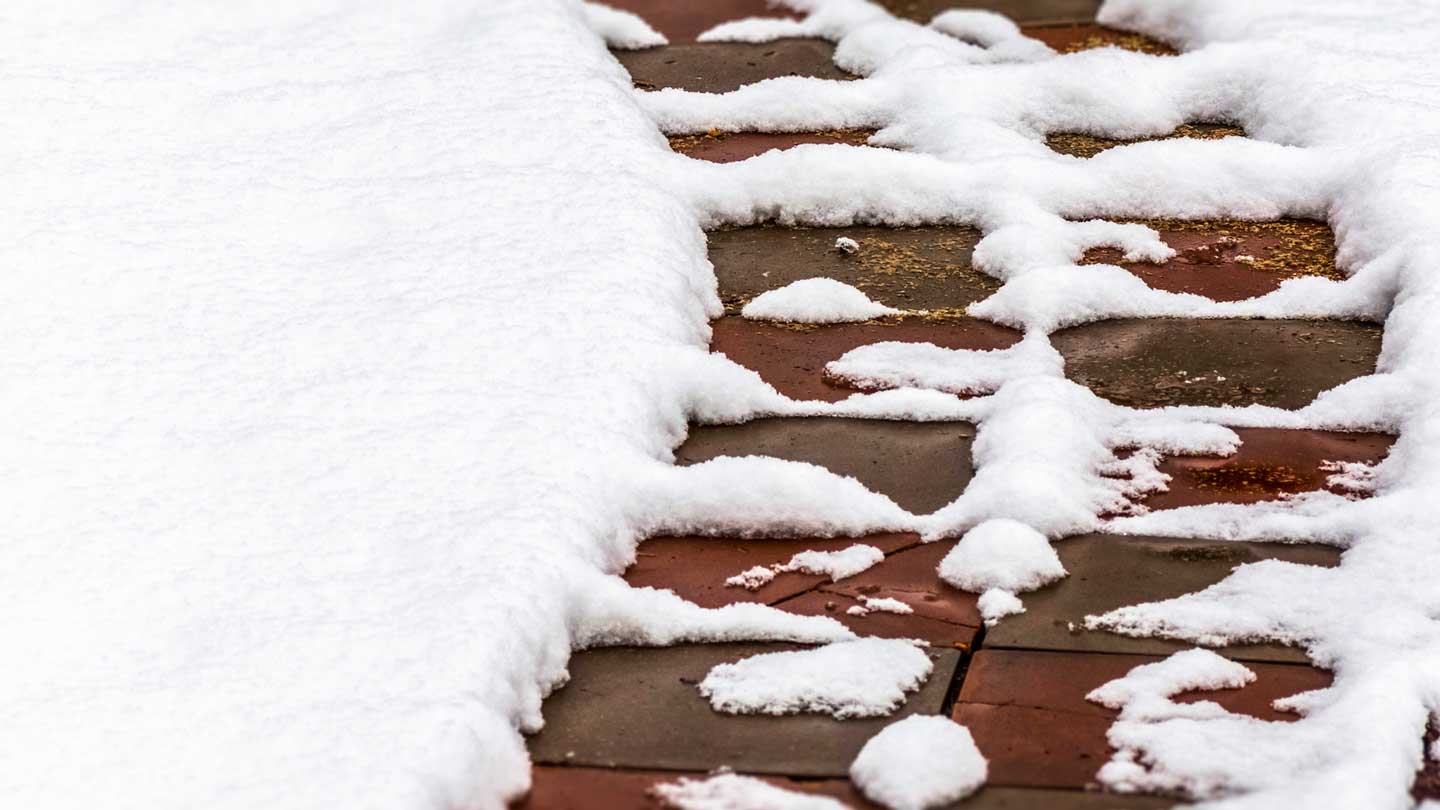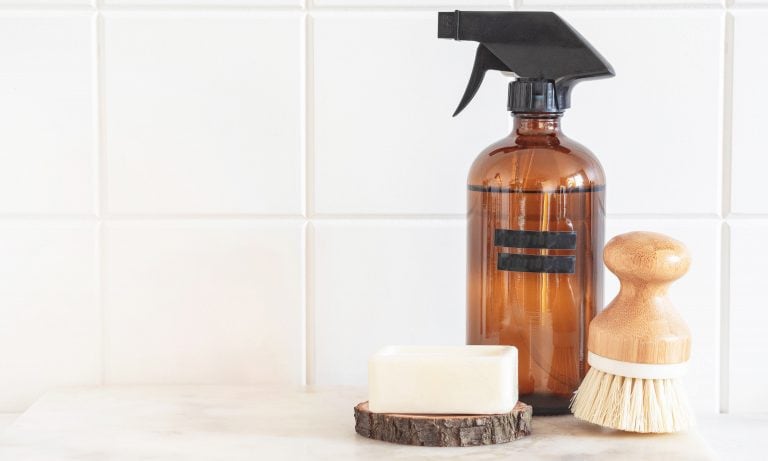Winter brings fun activities like galloping through the snow with your pup and cozying up with them by a fire—but it also means slush, mud, and muck. You know what that means? Muddy dog paws every time you come into the house from a walk.
It’s no fun to deal with dirty carpets and or scrub your floors. So, how do you handle those muddy toe beans? We asked both a home expert and a dog trainer for their top tips on how to clean dog paws.
8 Tips To Prevent Muddy Dog Paws This Winter
1. Keep the Fur Between Your Dog’s Paw Pads Trimmed

Here’s one thing you can do to minimize mess before you even leave the house for your walk: trim the fur between your dog’s paw pads. Extra fur can track in even more dirt and grime, so keeping the hair trimmed can be a big help.
If your pup has long hair growing between their toe beans (sometimes called “Grinch feet”), you can use clippers to gently trim it back.
2. Minimize Mud in Your Yard

You can also go right to the source when it comes to preventing mud from coming into your house: your yard. Home expert Lindsey Chastain, founder and CEO of the blog The Waddle and Cluck, based in Skiatook, Oklahoma, knows this from experience, since she has five dogs. “Rainy days can be a bit of a circus,” she says.
Mud tends to collect in areas that are lower in the yard, as well as areas that don’t have any kind of ground cover. “Fill in any holes in the yard with topsoil or dirt to minimize areas where puddles can form, and add some type of groundcover, like sod or groundcover plants,” Chastain says. “In areas that tend to get extra muddy, consider adding in a gravel pathway, pavers, or stepping stones.”
3. Put Dog Boots on Your Dog Before Going Outside

Dog boots are pretty darn adorable, but they’re practical too. You can train your dog to wear boots outside, and then pull them off—along with any mud attached—before entering your home.
“Getting your dog comfortable with boots can be a fun process,” says Liz Dimit, a certified dog trainer based in Phoenix and dog expert for boarding, daycare, and spa franchise Dogtopia.
“Start by introducing the boots gradually,” she says. “Let your dog sniff and explore them before you even try to put them on. Once they’re curious and comfortable, try putting one boot on for a short period—maybe for just a few minutes indoors, using lots of treats and praise to create positive associations. Then, slowly increase the time they wear them and add more boots as they get used to the feeling.”
4. Set Up a Washing Station

Creating a dog paw washing station can be a lifesaver if you’re trying to prevent mud from coming into the house. The first step, Chastain says, is to choose a good location for your dog paw wash. Choose an area of your home that has tile or other water-friendly flooring, a water source, and good drainage, such as:
- A bathroom
- Mudroom
- Garage
- Patio
“Dog wash stations can be as simple as a water hose on the patio, or you can have a dedicated station,” she says. “You will also want a basin, tub, or shower large enough for your dogs. And, of course, you will need towels. I prefer to have a hose or detachable shower sprayer, as that makes cleaning underneath the dogs a lot easier!”
Also, be sure to add safety features such as a non-slip mat, a safety harness (especially for raised platforms), and storage areas for supplies so they can be stored away safely.
“Make sure that you have both hot and cold water in the dog wash station so your dogs can be comfortable while being bathed,” Chastain adds.
5. Invest in Dog Cleaning Wipes

A tried-and-true dog feet cleaner is a pack of dog cleaning wipes. To fully take advantage of the wipes’ effectiveness, Dimit says, teach your dog to stop and wait by the door before coming inside. The stay skill can come in handy here.
“You can use a towel station and train them to wait before they enter,” she says. “This gives you a chance to dry off their paws or clean them with dog-friendly wipes.”
6. Try a Paw Plunger

Imagine if you could bathe your dog’s paws without having to soak the rest of them. Good news: A Paw Plunger lets you do just that. It’s a container with bristles or nubs inside. Just add water or soap, insert your dog’s paw, and let the plunger do the rest.
You can also try a more DIY approach by setting up a shallow bath near your door. Dimit recommends filling a short basin with water and teaching your dog to step into it before entering.
“Use lots of praise and rewards to keep it positive, so they see it as a game,” she says.
7. Teach Your Dog To Wipe Their Feet

Humans usually wipe their feet to avoid bringing mud into a house—and you can teach your dog to do the same!
“Teaching your dog to wipe their feet can be both practical and fun,” Dimit says. Follow these steps:
- Start by laying down a doormat and using a cue like “wipe” or “scrub.”
- Encourage your dog to step on the mat.
- When your dog naturally moves or scratches at the mat with their paws, reward them with treats and praise.
- If your dog doesn’t naturally wipe their paws, you can place a treat under the mat to encourage paw-scratching behavior.
“Repeat the process, and eventually, your dog will associate stepping on the mat and wiping their feet as a positive activity,” Dimit says.
As your dog gets used to wiping their paws or wearing boots, Dimit recommends adding calming music or a favorite toy to make the process even smoother.
8. Be Prepared for Mud

Perhaps you’ve tried all these tricks and tips, and your pup is still tracking mud into the house. It happens to all of us, even with our best efforts. Chastain says that while you can’t completely prevent muddy paws, you can take steps to keep the mud out of your home.
“When it’s muddy outside, supervise their time more than you would on a clear day,” she says. “For example, we minimize yard access on muddy days.” Choosing a leashed walk in a cleaner area over your usual playtime in your muddy backyard can do wonders to keep messes at bay—and your dog will probably like the excitement of a new activity too!
Share:


























